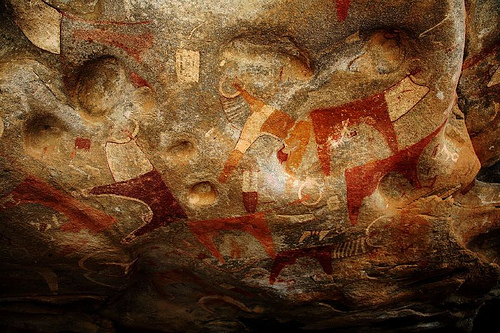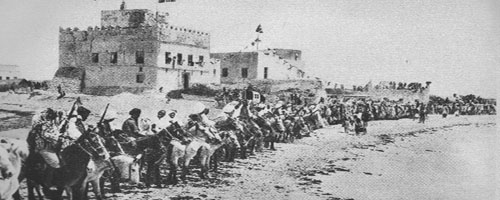|
26th Division (Somalia)
The 26th Division, (), also known as the Northern Division was the Somali Army division responsible for northern Somalia. It was headquartered in Hargeisa, Somalia. It consisted of 10 units. At one point it was one of five army divisions in Somalia. Muse Hassan Sheikh Sayid Abdulle has been referred to as commander of the 26th Division in 1970–71. In 1977, the division was responsible for the Dire Dawa front in the Ogaden War. Maxamed Xaashi “Gaani,” related to Barre’s second wife, was placed in charge of the twenty-sixth military region in 1980, and was in the area when the regime began large-scale repression against the Isaaq in 1981. in 1987 "Gaani" was appointed vice-minister of defence (or deputy minister). From 1986 to 1988, General Mohamed Said Hersi Morgan was the commander of the 26th Sector (the region of Somaliland) before being appointed Minister of Defense in September 1990. Divisions in the 26th Sector by this time included Division 1, Division 2 at Hargei ... [...More Info...] [...Related Items...] OR: [Wikipedia] [Google] [Baidu] |
Somali Army
The Somali National Army ( Somali: ''Xooga Dalka Soomaaliyeed,'' lit. ''"Somali Ground Forces"'') is the ground forces component of the Somali Armed Forces, and is the largest out of the three service branches that make up the majority of the Armed Forces. Since the nation's independence in 1960, the Army was engaged in various military operations in the Cold War to expand and increase Somalia's sphere of influence throughout the Horn of Africa counter to Ethiopia's and Kenya's ambitions, because of this, Somalia had amassed large ground forces. History The Trust Territory of Somalia established a national army to defend the nascent Somali Republic's borders. A law to that effect was passed on 6 April 1960. Thus the Somali Police Force's Mobile Group (Darawishta Poliska or Darawishta) was formed. 12 April 1960 has since been marked as ''Armed Forces Day''. British Somaliland became independent on 26 June 1960 as the State of Somaliland, and the Trust Territory of Somalia (th ... [...More Info...] [...Related Items...] OR: [Wikipedia] [Google] [Baidu] |
Division (military)
A division is a large military unit or Formation (military), formation, usually consisting of between 6,000 and 25,000 soldiers. In most armies, a division is composed of several regiments or brigades; in turn, several divisions typically make up a corps. Historically, the division has been the default combined arms unit capable of independent Military tactics, operations. Smaller combined arms units, such as the American regimental combat team (RCT) during World War II, were used when conditions favored them. In recent times, modern Western militaries have begun adopting the smaller brigade combat team (similar to the RCT) as the default combined arms unit, with the division they belong to being less important. While the focus of this article is on army divisions, in naval usage "division (naval), division" has a completely different meaning, referring to either an administrative/functional sub-unit of a department (e.g., fire control division of the weapons department) aboar ... [...More Info...] [...Related Items...] OR: [Wikipedia] [Google] [Baidu] |
Hargeisa
Hargeisa (; so, Hargeysa, ar, هرجيسا) is the capital and largest city of the Republic of Somaliland. It is located in the Maroodi Jeex region of the Horn of Africa. It succeeded Burco as the capital of the British Somaliland Protectorate in 1941. Hargeisa is the largest city in Somaliland, and also served as the capital of the Isaaq Sultanate during the mid-to-late 19th century. Hargeisa was founded as a watering and trading stop between the coast and the interior by the Isaaq Sultanate. Initially it served as a watering Well for the vast livestock of the Eidagale clans that inhabited in that specific region and later were joined by the current clans of Hargeisa. In 1960, the Somaliland Protectorate gained independence from the United Kingdom and as scheduled united days later with the Trust Territory of Somaliland (former Italian Somaliland) to form the Somali Republic on July 1. Encyclopædia Britannica, ''The New Encyclopædia Britannica'', (Encyclopædia Britanni ... [...More Info...] [...Related Items...] OR: [Wikipedia] [Google] [Baidu] |
Somalia
Somalia, , Osmanya script: 𐒈𐒝𐒑𐒛𐒐𐒘𐒕𐒖; ar, الصومال, aṣ-Ṣūmāl officially the Federal Republic of SomaliaThe ''Federal Republic of Somalia'' is the country's name per Article 1 of thProvisional Constitution, (; ), is a country in the Horn of Africa. The country is bordered by Ethiopia to the west, Djibouti to the northwest, the Gulf of Aden to the north, the Indian Ocean to the east, and Kenya to the southwest. Somalia has the longest coastline on Africa's mainland. Its terrain consists mainly of plateaus, plains, and highlands. Hot conditions prevail year-round, with periodic monsoon winds and irregular rainfall. Somalia has an estimated population of around million, of which over 2 million live in the capital and largest city Mogadishu, and has been described as Africa's most culturally homogeneous country. Around 85% of its residents are ethnic Somalis, who have historically inhabited the country's north. Ethnic minorities are ... [...More Info...] [...Related Items...] OR: [Wikipedia] [Google] [Baidu] |
Muse Hassan Sheikh Sayid Abdulle
Muse Hassan Sheikh Abdulle ( so, Muuse Xasan Sheekh Cabdulle, ar, موسى حسن الشيخ سعيد عبد الله), also known as Muse Sayyid Hassan, is a senior Somali military figure and politician. He has been the acting president of Somalia and interim speaker of the Federal Parliament. Abdulle is Somalia's ambassador to Italy. Biography His name is transliterated in various ways including ''Musa Hassan Abdulle''. Mussa Hassan was born in 1940 in Shilabo, Ogaden. Abdulle hails from Bahgeri sub-clan of the larger Ogaden Absame Kuumade Darod clan. Career Military career Abdulle was a prominent member of the Somali National Army. He was among the first three Somali cadets to graduate from the Military Academy of Modena (Accademia Militare di Modena), located in Modena, northern Italy. In 1985, Abdulle received a fellowship to attend the National Defense University in Washington, D.C. He graduated from the institution the following year. Federal Government of Somalia Feder ... [...More Info...] [...Related Items...] OR: [Wikipedia] [Google] [Baidu] |
Ogaden War
The Ogaden War, or the Ethio-Somali War (, am, የኢትዮጵያ ሶማሊያ ጦርነት, ye’ītiyop’iya somalīya t’orineti), was a military conflict fought between Somalia and Ethiopia from July 1977 to March 1978 over the Ethiopian region of Ogaden. Somalia's invasion of the region, precursor to the wider war,. met with the Soviet Union's disapproval, leading the superpower to end its support of Somalia and support Ethiopia instead. Ethiopia was saved from defeat and permanent loss of territory through a massive airlift of military supplies worth $1 billion, the arrival of more than 12,000 Cuban soldiers and airmen sent by Fidel Castro to win a second African victory (after his first success in Angola in 1975–76), and 1,500 Soviet advisors, led by General Vasily Petrov. On 23 January 1978, Cuban armored brigades inflicted the worst losses the Somali forces had ever taken in a single action since the start of the war. The Cubans (equipped with 300 tanks ... [...More Info...] [...Related Items...] OR: [Wikipedia] [Google] [Baidu] |
Isaaq
The Isaaq (also Isaq, Ishaak, Isaac) ( so, Reer Sheekh Isxaaq, ar, بني إسحاق, Banī Isḥāq) is a Somali clan. It is one of the major Somali clans in the Horn of Africa, with a large and densely populated traditional territory. Perry–Castañeda Library Map Collection – N.B. Various authorities indicate that the Isaaq is among the largest Somali clan The clan-family traces their lineage to Ishaaq bin Ahmed, Sheikh Ishaaq bin Ahmed, an Arab Islamic scholar who purportedly traveled to Somaliland in the 12th or 13th century and married into the local Dir clan, though this story is probably legendary. Overview According to genealogical books and Somali tradition, the Isaaq clan was founded in the 12th or 13th century with the arrival of Sheikh Ishaaq Bin Ahmed (Sheikh Ishaaq) from Arabia.Rima Berns McGown, ''Muslims in the diaspora'', (University of Toronto Press: 1999), pp. 27–28I.M. Lewis, ''A Modern History of the Somali'', fourth edition (Oxford: James Cu ... [...More Info...] [...Related Items...] OR: [Wikipedia] [Google] [Baidu] |
Mohamed Said Hersi Morgan
Major General Mohammed Said Hersi Morgan ( so, Maxamed Siciid Xirsi Moorgan, ar, محمد سعيد حيرسي مورغان), also known as General Morgan or Colonel Morgan, is a Somali military and faction leader. He was the son-in-law of Siad Barre and Minister of Defence of Somalia. He hails from the Mejerteen Darood clan . Career Siad Barre Government Morgan received his military training in Italy and the USA. As a colonel, he was commander of the Mogadishu sector, where the elite units of the Armed Forces were stationed (ca. 1980); this was probably Sector 77. Morgan then went on to become commander of the Red Berets, responsible for the suppression of the revolt of the Majerteen United in the Somali Salvation Democratic Front (SSDF) in 1982. From 1986 to 1988, as a general, he was the military commander of the 26th Sector (the region of Somaliland) and in September 1990 he was appointed as minister of defense and substitute head of state. Somali Civil War Before the ... [...More Info...] [...Related Items...] OR: [Wikipedia] [Google] [Baidu] |
Military Of Somalia
The Somali Armed Forces are the military forces of the Federal Republic of Somalia. Headed by the president as commander-in-chief, they are constitutionally mandated to ensure the nation's sovereignty, independence and territorial integrity. Chapter 14, Article 126(3). The SAF was initially made up of the Army, Navy, Air Force and Police Force. In the post-independence period, it grew to become among the larger militaries in Africa. Due to Barre's increasing reliance on his own clans, repressive policies, and the Somali Rebellion, the military had by 1988 begun to disintegrate. By the time President Siad Barre fled Mogadishu in January 1991, the last cohesive army grouping, the 'Red Berets,' had deteriorated into a clan militia. An unsteady rebuilding process began after 2000. In January 2014, the security sector was overseen by the Federal Government of Somalia's Ministry of Defence, Ministry of National Security, and Ministry of Interior and Federalism. The northeastern region ... [...More Info...] [...Related Items...] OR: [Wikipedia] [Google] [Baidu] |

